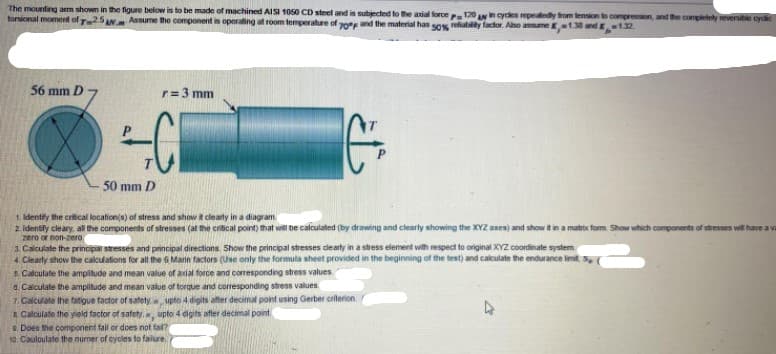ions. Show the principal stresses dearty in a stress element fors (Use only the formula sheet provided in the beginni ce and comesponding stress values and coresponding stress values s after decimal pont using Gerber criterion after decimal point
ions. Show the principal stresses dearty in a stress element fors (Use only the formula sheet provided in the beginni ce and comesponding stress values and coresponding stress values s after decimal pont using Gerber criterion after decimal point
Mechanics of Materials (MindTap Course List)
9th Edition
ISBN:9781337093347
Author:Barry J. Goodno, James M. Gere
Publisher:Barry J. Goodno, James M. Gere
Chapter1: Tension, Compression, And Shear
Section: Chapter Questions
Problem 1.9.18P: The piston in an engine is attached to a connecting rod AB, which in turn is connected to a crank...
Related questions
Question

Transcribed Image Text:The mounting arm shown in the figure below is to be made of machined AISI 1050 CD steel and is subjected to the aial force 120 An cyces repeatedy from tension to compression, and the completely reversitie cycd
torsional moment of T25AN Assume the component is operating at room temperature of 0 and the material has sos refiablity factor. Aso asume K138 and-132
56 mm D
r=3 mm
%3D
50 mm D
1. Identity the critical location(s) of stress and show it clearly in a diagram
2 Identify cleary, all the components of stresses (at the critical point) that will be calculated (by drawing and clearly showing the XYZ axes) and show it in a matrix form Show which components of stresses will have a va
zero or non-zero
3. Calculate the principar stresses and principal directions. Show the principal stresses dearty in a stress element with respect to original XYZ coordinate system
4. Clearly show the calculations for all the 6 Marin factors (Use only the formula sheet provided in the beginning of the test) and calculate the endurance limit, s,
5 Calculate the amplitude and mean value of axial force and coresponding stress values
a. Calculate the ampitude and mean value of torque and corresponding stress values.
7. Calculate the fatigue factor of satety upto 4 digits after decimal point using Gerber criterion
8 Calculate the yield factor of safety, upto 4 digits after decimal point
0. Does the component fail or does not fal?
10. Cauloulate the numer of cycles to failure
Expert Solution
This question has been solved!
Explore an expertly crafted, step-by-step solution for a thorough understanding of key concepts.
Step by step
Solved in 2 steps with 2 images

Knowledge Booster
Learn more about
Need a deep-dive on the concept behind this application? Look no further. Learn more about this topic, mechanical-engineering and related others by exploring similar questions and additional content below.Recommended textbooks for you

Mechanics of Materials (MindTap Course List)
Mechanical Engineering
ISBN:
9781337093347
Author:
Barry J. Goodno, James M. Gere
Publisher:
Cengage Learning

Mechanics of Materials (MindTap Course List)
Mechanical Engineering
ISBN:
9781337093347
Author:
Barry J. Goodno, James M. Gere
Publisher:
Cengage Learning